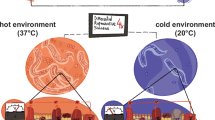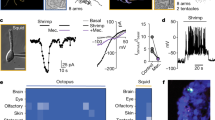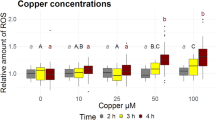Abstract
TASAKI et al.1,2 have demonstrated the existence of prolonged action potentials in the squid axon under tetraethylammonium and of a “hyperpolarizing response” of the normal squid axon in enriched potassium solutions. In a series of experiments they have evaluated the properties of the squid axon membrane in these two particular environments and were led to the conclusion that the Hodgkin–Huxley3 equations did not account for their observations, which had to be explained instead in terms of a “bistable state” hypothesis.
This is a preview of subscription content, access via your institution
Access options
Subscribe to this journal
Receive 51 print issues and online access
$199.00 per year
only $3.90 per issue
Buy this article
- Purchase on SpringerLink
- Instant access to full article PDF
Prices may be subject to local taxes which are calculated during checkout
Similar content being viewed by others
References
Tasaki, I., and Hagiwara, S., J. Gen. Physiol., 40, 859 (1957).
Tasaki, I., J. Physiol., 148, 306 (1959).
Hodgkin, A. L., and Huxley, A. F., J. Physiol., 117, 500, 544 (1952).
George, E. P., and Johnson, E. A., Austral. J. Exp. Biol. and Med. Sci., 39, 385 (1961).
Fitzhugh, R., J. Gen. Physiol., 43, 867 (1960).
Spyropoulos, C. S., Amer. J. Physiol., 200, 203 (1961).
Huxley, A. F., Ann. N.Y. Acad. Sci., 81, 215 (1959).
Frankenhaeuser, B., and Hodgkin, A. L., J. Physiol., 137, 218 (1957).
Author information
Authors and Affiliations
Rights and permissions
About this article
Cite this article
GEORGE, E., JOHNSON, E. Response of the Hodgkin–Huxley Model to Temperature and Chemical Impulses. Nature 194, 874–875 (1962). https://doi.org/10.1038/194874a0
Issue date:
DOI: https://doi.org/10.1038/194874a0



